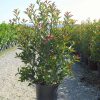The amount of water your landscape requires and the amount of water it receives will determine its overall health and beauty. Proper watering techniques are a critical part of landscape maintenance and ultimately the key to plant survival.
Plant selection is crucial; when choosing your plants, select varieties that are better adapted to our climate. Doing so will result in plants that are easier to care for and are better suited for our North Texas summer heat.
New Sod:
Begin watering new sod within a half hour after it has been laid. Water to a depth of 1 inch so that the soil beneath the turf becomes saturated. The soil below the surface should be moist 3-4 inches deep. For the next two weeks keep the soil surface moist with daily watering. Additional and more frequent watering may be needed during periods of high wind and excessive heat. Watering early in the morning when possible will allow the new sod to absorb moisture more easily as well as lessening the loss of water due to evaporation.
Established Lawns:
One inch of water a week is the standard requirement for most lawns; however, this will vary with different types of turf. Water requirements will differ from season to season as well as with different soil types.
During the growing season most lawns will survive with as little as one inch of water per week, this being from rain or from the homeowners water source. When applied properly this amount of water is all that is required for a healthy lawn, make sure to water evenly and to saturate the underlying soil to a depth of 4 to 6 inches. You may need to calculate the amount of time it takes to accumulate this amount of water to the desired depth. Try using an old coffee can or some other container that can be marked, place this can in the desired area to be watered, set the sprinkler to run until you have accumulated one inch of water, this lets you know how long it takes to water to a depth of one inch.
Infrequent and deep watering is best because the roots will only grow as deep as its most available water supply. Deeply watered lawns have a larger water source that allows it to survive for longer periods between watering.
Examine your lawn to determine its watering needs. Turf that is in need of water will have a dull green color instead of the usual bright green. Pay close attention as you walk across the turf, you will notice footprints. If you can still see your foot prints in the yard after 20-30 minuets this is a sure sign that the turf requires immediate attention.
New Trees & Shrubs:
Water all newly planted Trees & Shrubs immediately after planting. In order to become established, most newly planted Trees & Shrubs require regular watering for at least six months to one year.
Again deep infrequent watering is the key to establishing a healthy deep-rooted plant that will require less water over time. Water to a depth of at least 4-6 inches in order to saturate the underlying root system. Concentrate the water to the area around the root ball rather than on the leaves, this allows for quicker absorption through the root system instead of the foliage. The type of soil, recent rainfall and time of year will ultimately determine amount of water that will be needed.
Placing a 3-4 inch layer of organic mulch around newly planted trees and shrubs will help reduce water loss due to evaporation and also help maintain soil temperature. Organic mulches also help by returning valuable nutrients back into the soil as the mulch begins to decompose.
Watering at night can increase the chances of fungus and disease related problems, with the foliage staying wet late into the evening hours this is the perfect place for fungus to attack. Watering in the early morning allows the plant to dry completely throughout the day allowing the plant to more readily absorb the water with less water loss due to evaporation.
Established Trees & Shrubs:
A soaker hose is ideal for watering large shrub beds. When watering large trees a “Gator Bag” is handy, It releases water slowly and economically. It will not wet the foliage, in turn it lessens the chance of fungus and disease development. You can use automatic sprinkler systems also, but be sure to calibrate the amount of time it takes to adequately water every location. Established Shrubs should be watered to a depth of 10 to 12 inches deep, this can take up to 2 hours of continuous irrigation. Sprinklers with low output heads or bubblers that decrease water run off are an efficient way to water. Using sprinklers that produce large drops of water will increase the amount of water available to the plant without loss of water due to evaporation.
Allow the soil surface to dry out lightly between watering’s. The majority of root development will be at greater depths where soil moisture is higher. For established Trees and Shrubs, watering should be done every 7 to 10 days during prolonged periods of drought or dry spells. During cooler seasons, less watering is needed because evaporation from the leaves occurs more slowly.
A 3-4 inch layer of organic mulch placed around established plant material will help reduce water loss due to evaporation and also help maintain soil temperature. Organic mulches also help by replacing valuable nutrients back into the soil as the mulch begins to decompose.
Different plants have different water needs, where some are quite drought tolerant others are not. Plants with large leaves such as hydrangeas or azaleas with shallow root systems are usually the first to suffer during long periods of drought. Shrubs under large trees are more susceptible because of the large volumes of water taken up by the Trees large root system. New plants are more apt to suffer from drought during the first two growing seasons. Late spring or summer transplants are the most susceptible, because their roots have a shorter time to become established before the summer stress. When there is an extended period without rain, new plants should be watered at least once a week.
Watering plants according to their needs, with a planned irrigation routine will help insure a healthy and productive landscape all season long and for years to come.



